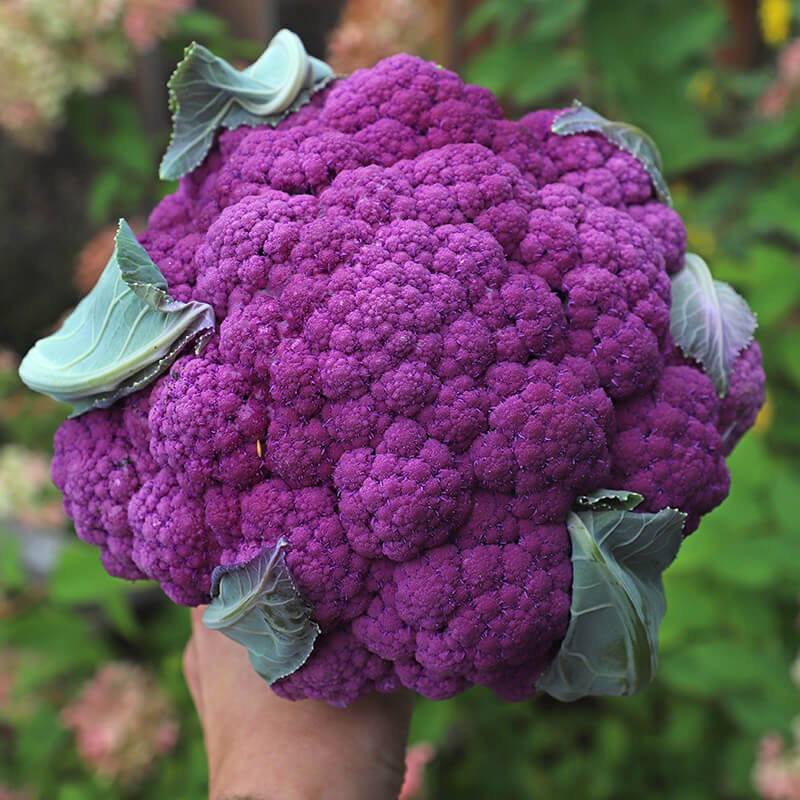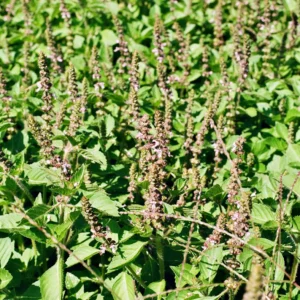Grafitti variety of cauliflower.
Description of Grafitti variety of cauliflower.
The Graffiti variety of cauliflower is visually stunning, with vibrant purple heads that stand out in the garden. Its striking color comes from anthocyanins, which are natural pigments also found in red cabbage and blueberries. Despite its unconventional appearance, Graffiti cauliflower has a mild, slightly sweet flavor similar to traditional white cauliflower. It can be enjoyed raw in salads, roasted, steamed, or used in any recipe calling for cauliflower, adding a pop of colour to dishes.
To plant the Graffiti variety of cauliflower:
- Timing: Plant Graffiti cauliflower in the same timing as other cauliflower varieties—early spring for a late spring or early summer harvest, or in late summer for a fall harvest.
- Soil preparation: Choose a sunny location with well-draining soil. Ensure the soil is rich in organic matter and has a pH between 6.0 and 7.0. If needed, amend the soil with compost or well-rotted manure before planting.
- Starting seeds indoors (optional): Graffiti cauliflower seeds can be started indoors 4-6 weeks before the last expected frost date. Use seed starting trays filled with seed starting mix. Plant seeds ¼ inch deep and keep the soil consistently moist until seedlings emerge.
- Direct seeding: Alternatively, sow Graffiti cauliflower seeds directly into the garden when the soil temperature reaches around 60°F (15°C). Plant seeds ½ inch deep, spacing them 18-24 inches apart in rows spaced 24-36 inches apart.
- Watering: Keep the soil consistently moist but not waterlogged. Cauliflower plants require regular watering, especially during dry periods. Mulching around plants can help retain moisture and suppress weeds.
- Fertilization: Once the plants are established, provide them with a balanced fertilizer rich in nitrogen.
- Pest and disease management: Monitor for common cauliflower pests such as aphids, cabbage worms, and cabbage loopers. Implement organic pest control methods if necessary.
- Harvesting: Graffiti cauliflower heads are ready to harvest when they reach a desirable size and have a tight, compact appearance. Harvest before the heads start to separate or discolour. Use a sharp knife to cut the heads from the plant, leaving a few inches of stem attached.
Description of Grafitti variety of cauliflower.
The Graffiti variety of cauliflower is visually stunning, with vibrant purple heads that stand out in the garden. Its striking color comes from anthocyanins, which are natural pigments also found in red cabbage and blueberries. Despite its unconventional appearance, Graffiti cauliflower has a mild, slightly sweet flavor similar to traditional white cauliflower. It can be enjoyed raw in salads, roasted, steamed, or used in any recipe calling for cauliflower, adding a pop of colour to dishes.
To plant the Graffiti variety of cauliflower:
- Timing: Plant Graffiti cauliflower in the same timing as other cauliflower varieties—early spring for a late spring or early summer harvest, or in late summer for a fall harvest.
- Soil preparation: Choose a sunny location with well-draining soil. Ensure the soil is rich in organic matter and has a pH between 6.0 and 7.0. If needed, amend the soil with compost or well-rotted manure before planting.
- Starting seeds indoors (optional): Graffiti cauliflower seeds can be started indoors 4-6 weeks before the last expected frost date. Use seed starting trays filled with seed starting mix. Plant seeds ¼ inch deep and keep the soil consistently moist until seedlings emerge.
- Direct seeding: Alternatively, sow Graffiti cauliflower seeds directly into the garden when the soil temperature reaches around 60°F (15°C). Plant seeds ½ inch deep, spacing them 18-24 inches apart in rows spaced 24-36 inches apart.
- Watering: Keep the soil consistently moist but not waterlogged. Cauliflower plants require regular watering, especially during dry periods. Mulching around plants can help retain moisture and suppress weeds.
- Fertilization: Once the plants are established, provide them with a balanced fertilizer rich in nitrogen.
- Pest and disease management: Monitor for common cauliflower pests such as aphids, cabbage worms, and cabbage loopers. Implement organic pest control methods if necessary.
- Harvesting: Graffiti cauliflower heads are ready to harvest when they reach a desirable size and have a tight, compact appearance. Harvest before the heads start to separate or discolour. Use a sharp knife to cut the heads from the plant, leaving a few inches of stem attached.





